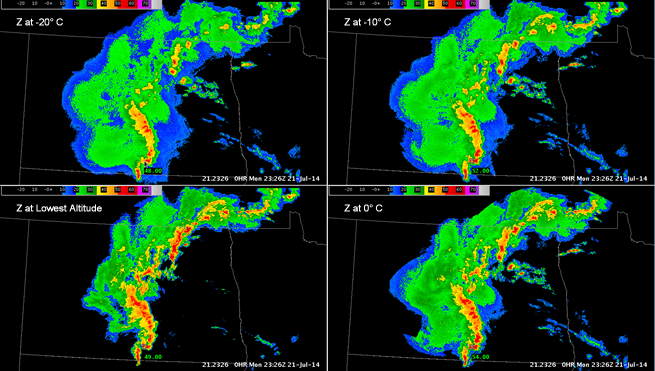Reflectivity at x°C - Warning Decision Training Division (WDTD)
Navigation Links
Products Guide
Reflectivity at x°C
Short Description
The reflectivity on a constant temperature surface.
Subproducts
Reflectivity at 0°C
Reflectivity at -5°C
Reflectivity at -10°C
Reflectivity at -15°C
Reflectivity at -20°C
Primary Users
NWS: WFO, CWSU, AWC
Input Sources
3D Reflectivity Cube
Vertical temperature profile from the current operational NCEP/EMC mesoscale model (i.e., the RAP as of 2015).
Resolution
Spatial Resolution: 0.01o Latitude (~1.11 km) x 0.01o Longitude (~1.01 km at 25oN and 0.73 km at 49oN)
Temporal Resolution: 2 minutes
Product Creation
Isothermal reflectivity products are computed by finding the reflectivity at an altitude corresponding to a certain temperature value (0°C, -5°C, -10°C, -15°C, or -20°C) that was obtained from an analysis of the near-storm environment by a mesoscale model.
At each horizontal 2D grid point, the altitude of the particular temperature value (e.g., 0°C) is checked from the top-down. Once the temperature value becomes greater than the temperature being searched for, the altitude is computed by interpolating between the current level and the previous higher level. This calculation method accounts for low-level inversions in the temperature profile by specifically targeting altitudes that are associated with deep convection (e.g., elevated convection over shallow cold layers).
The isothermal reflectivity at that temperature altitude is then computed by interpolating the reflectivity between the two vertically adjacent grid points.
Technical Details
Latest Update: MRMS Version 10
References
None




